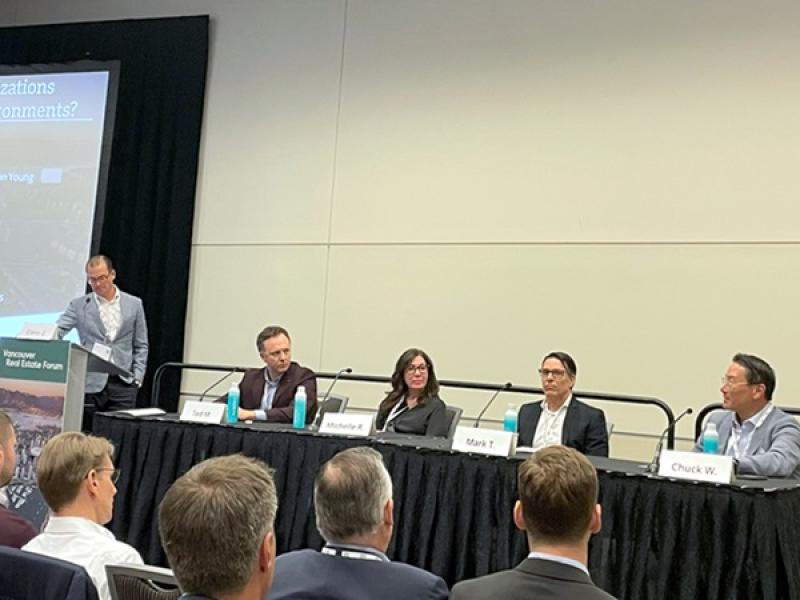
What’s one of the biggest threats facing Vancouver’s office market?
In a few years, the market could return to critically low vacancy, especially in the city’s stock of class-AAA inventory, due to trepidation by developers to permit, design and build new towers in the downtown core.
That’s Mark Trepp’s belief, and one he shared during a panel on April 3 at the Vancouver Real Estate Forum. While the executive vice-president of JLL in Vancouver acknowledges that might seem counter-intuitive, given Vancouver is experiencing its highest office vacancy in the last two decades, Trepp says we’re at the end of a major building cycle and the demand for best-in-class office could gobble up more space quicker than many expect.
In some cases, it can take up to a decade to develop a new class-AAA office tower in Vancouver, including securing land, arranging permissions, designing and constructing the building, and completing tenant build-outs. As construction and development costs surge, it’s getting tougher to arrange traditional financing for office towers, Trepp and other panelists said.
Elevated office vacancy nationwide isn’t helping.
Whether tenants will again experience a space crunch similar to the pre-pandemic situation is up for debate and only the future will tell. There is , however, plenty of agreement among office insiders that there are signs of stabilization in the local market and a flight to quality taking place — but launching a new office tower isn’t so simple.
Vancouver office vacancy appears to have peaked
Since downtown Vancouver office vacancy reached 12.6 per cent in Q2 2023, the vacancy has flattened for consecutive quarters, according to data presented by Avison Young principal Glenn Gardner.
”I think we’ve just about hit that peak, or we’re very close to it, and we’re going to start to see that trend back down.”
He said the sublease market is also flattening and possibly trending down, while openings of new office towers have halted.
Gardner said the two latest buildings, B6 by BentallGreenOak and The Post building two, which is occupied by Amazon, have been delivered. A new four-storey, 51,000-sq.-ft. office building by Bonnis Properties on Granville Street is 69 per cent leased. “But . . . as we sit here today, there’s nothing else coming in.”
If current absorption trends continue, the market could end up at eight per cent vacancy by 2028, Gardner said. But if absorption escalates to 150 per cent of the current rate, the market could end up at five per cent vacancy.
Looking at class-AAA buildings only, vacancy could fall as low as 2.2 per cent by 2028 if the market experiences 150 per cent absorption during that time frame, Gardner added.
Trepp said current conditions are a return to health for the market. In late 2019, if tenants were seeking a space of 40,000 sq. ft. or larger downtown, they had three options, Trepp said. If they were seeking a space of 100,000 sq. ft., there was one option. “Today, if you’re looking for 40,000 sq. ft., you’ve got 16 options downtown, and if you’re looking for 100,000 sq. ft. or more, you’ve got six. That’s a much healthier market.”
Moreover, Trepp and his fellow panelists agreed Vancouver’s tenant mix is more diverse than ever with tech companies, law firms, accounting firms and even mining and natural resource companies showing a renewed eagerness for space.
There are threats out there
“What keeps me up at night is that multiple sectors kind of go backwards,” according to Chuck We, executive vice-president, Pacific Northwest/Canada office operations with Hudson Pacific Properties, the owner of Bentall Centre. While tech demand is blunted right now, any new retreat by the industry locally could spell trouble.
We said the education sector is another risk as the federal government plans to reduce the number of foreign students coming in (meanwhile, the B.C. government is cracking down on dubious post-secondary organizations operating as student visa mills).
Any substantial increase to the cost of capital would also hurt demand, We added.
“It’s going to sound paradoxical, but (the main threat is) a lack of supply,” Trepp said, explaining that if most demand stays focused on the top-quality offices, the current vacancy of roughly 13 per cent will start to come down.
“Now, that’s roughly 2.3 million square feet,” he said. “Last year, there was 800,000 square feet of positive absorption in the class. If we had three years like that, we’re out of space.”
If absorption reverts to the mean, the market could experience a space crunch in five years, Trepp added.
“Nobody’s building; nothing’s delivering in the next five years, so I think that’s the biggest risk,” he said.
Amenities race involves hospitality play
Ted Mildon, vice-president office leasing and operations with Oxford Properties, said tenants are increasingly seeking more hospitality from their office environments. “People need to feel special every day when they come to the office,” he said.
Fellow panelist Michelle Roundell agreed. The client relationship leader with design firm Gensler said a concierge service that can help office workers achieve more while they’re at work is becoming an important office amenity.
“So, is it somebody getting me tickets? Or washing my car and vacuuming my car? Is it child care? Dry cleaning? . . . What can be done while I’m working that I don’t have to do at the end of the day?”
Recent JLL research out of the U.S. identified tenants’ five most desired amenities, Trepp said, listing: rooftop decks, fitness facilities (with changing rooms and showers), LEED certification, car charging stations and food courts as the leading desired amenities. “By a huge margin, the rooftop amenity deck was the number one amenity that was resulting in higher occupancy levels and higher returns.”
Kicking off the next building isn’t so simple
Setting daunting office building development timelines aside, there could be an opportunity for an accomplished developer to launch a new office, Mildon said. But that will require tenants playing a proactive role.
That could result in a build-to-suit style development that includes one or more tenants with a keen vision for their space needs.
“I think that’s the way it’s going to evolve, where someone with a great reputation . . . gets approached by a tenant who says, ‘here’s our vision for what we want to build for a great workspace. Can you help us do it?’ ”
However, Trepp cautioned that the last pro-forma he saw showed a new office building would need rents of at least $80 per square foot to get an economic return, given high construction costs, land values and development timelines. Rent for prime space today is roughly $55.
“We’ve never seen that sort of appreciation in Vancouver, and we were in a market where we had three per cent vacancy,” he said. “That’s really the impediment to new construction.”









